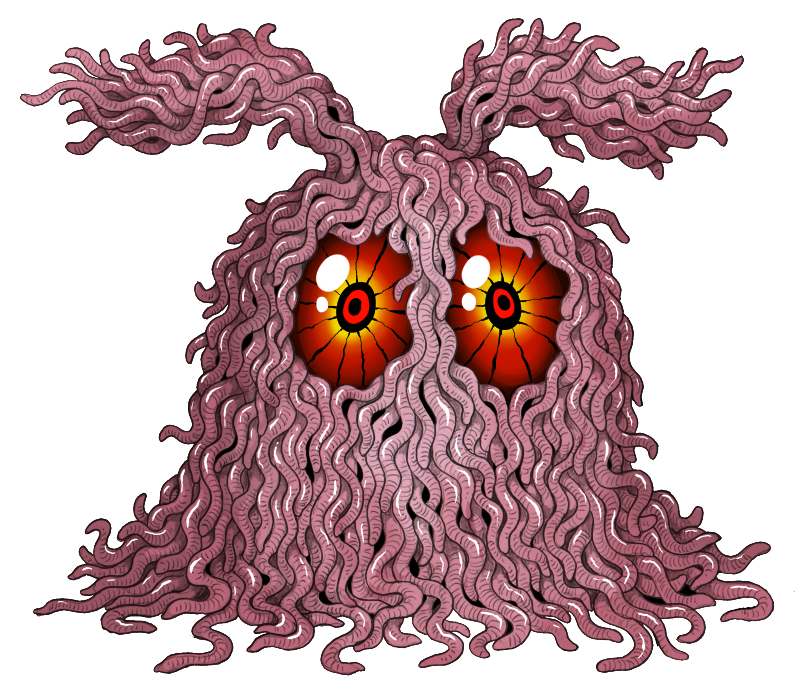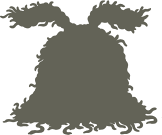|

CLASS: BIOCONSTRUCT BIOLOGY: Connected together by a network of fine "roots" and an adhesive, mucous secretion, each of a Wormonia's many bodies is a complete organism with nine hearts, 22 brains, a functional digestive tract and an eversible proboscis lined with 600 minute, razor-like teeth. Bodies can freely detach or reconnect to the collective mass, and permanently lost individuals regenerate quickly. Feeding on almost any organic materials available, it distributes nutrients evenly throughout its bodies. The massive eyes of the monster a Wormonia are its control center, each housing a ring of ganglia and a gas bladder affording the monster a degree of buoyancy in water or even air. Emitting harmless but steady levels of radiation from its retinas, it can peer through several feet of matter to locate food or avoid hidden predators. Wormonia reproduce two to a dozen at a time, forming a "mating ball" in which worms are freely redistributed amongst all participants. Within days, a fertilized Wormonia's eyes will complete division into two complete, fully grown pairs, each taking exactly half of the colony as they part ways. BEHAVIOR: A Wormonia is always on the prowl for food, emitting a series of excited hoots and tweets when it smells decay, and demonstrates a significant preference for zombie spawn over inert carrion, often patrolling the corpse sea in search of these treats. Above all else, however, is the Wormonia's appetite for parasitic worms of every variety, employing its penetrative vision to pinpoint the location of choice trematodes and nematodes with little regard to their hosts. When threatened, a Wormonia can vent its gases to propel itself into the air, flaring its bodies into an umbrella-like shape and flapping its upper pseudopods to drift for an impressive distance. It may attempt to land over an aggressor's face, driving hundreds of its worms into the foe's eyes, ears and nostrils. As a last-ditch escape maneuver, it may shed all of its worms simultaneously while the eyes float to safety, later regenerating their colony in a slimy cocoon. APPLIANCE: Wormonia are quite dangerous for their small size, capable of hiding their amorphous forms virtually anywhere and carefully guiding their worms through organic material from a distance. Only a single worm need reach a vital organ for the diminutive monster to vanquish an adversary or even exert a crude form of motor control over the subject, discouraging noncompliance by drilling ever deeper into a sensitive enough point. The Wormonia's appetite for parasitic prey is the bane of brain-flukes and other parasitic or parasitoid monsters, and it can swiftly shut down all function in a wormbrain-class monster. Properly trained, it can even purge unwanted parasites with minimal damage to the host. Wormonia are widely regarded as exceptionally frightening monsters, even beyond rational levels of caution. This appears to be largely cultural, further perpetuated by the influence of brain-flukes and other parasitic sentients. They are quite common atmospheric dressing in horror narratives, and false, rubber Wormonia, commonly dangled from an elastic cord, are a popular practical joke and gag gift in cerebroparasitic subculture. SWARMFORM: most of the Wormonia consists of many small, individually functional bodies, allowing the creature to freely split apart and recombine. FLESHBORE: a Wormonia's worms can tunnel quickly through flesh and viscera, causing significant discomfort and potential fatality. ANTIPARASITIC: the monster can free allies from parasitic threats and deactivate enemy combatants dependent upon parasitic symbionts. X-RAY VISION: the monster can see through several layers of solid material, easily spotting hidden threats and identifying critical internal weaknesses in its targets. GASEOUS LEAP: the monster can vent its buoyant gases to propel itself through the air.   Contents copyright Jonathan Wojcik
|